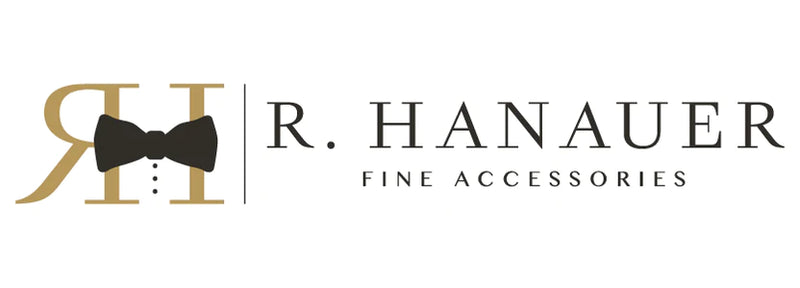How to Wear a Tie Clip

Tie clips or tie pins, tie tacks, and tie bars or tie slides - all serve the same purpose. But each offers the well-dressed gentleman a different look.
In this article, the R. Hanauer team addresses the five most common questions around these accessories:
- What is a tie clip for?
- What are the differences between the tie clip, tie pin, tie tack, tie slide and tie bar?
- Where is proper tie clip placement?
- How to wear a tie clip
- Which tie accessory is best suited to which necktie fabric or color?
1. What Is a Tie Clip For?
A tie clip (or tie tack/pin or slide/bar) is a piece of functional, decorative jewelry - usually metal - that secures a necktie in place.
As handsome as it is useful, a tie clip keeps neckwear out of harm’s way at meal time, work or appointments - and as straight as 6 o’clock, no matter your movement or the wind.

2. What Is the Difference Between a Tie Tack, Tie Pin, Tie Clip, Tie Slide and Tie Bar?
A tie tack and a tie pin are the same thing, and - as the names imply - they have a sharp element that pierces through the tie in order to secure it to the shirt. Sometimes a tack or pin will have a chain that can be tucked through and fastened into a button hole to lock it into place.
There are differences when considering a tie clip versus a tie bar, though. A tie clip (see image below) has a small hinge that opens to clasp the tie and shirt placket, and closes to hold them together.

A tie bar (also known as a tie slide), on the other hand, is a single piece of metal that uses tension to hold the tie and shirt together, like a money clip.

3. Where Is Proper Tie Clip Placement?
Regardless of which option you choose, the vertical placement of your tie accessory will be about the same.
Depending on your height and the cut of your jacket, you’ll want to secure your tie at or between the third and fourth button hole of your shirt. Higher and it won’t properly secure your tie; lower and it’ll be hidden by your jacket.
A tie clip or tie bar should be attached from the right side of the necktie in order to pick up the placket. For the same reason, a tie tack or tie pin should be secured in the middle of the tie blade.

4. How to Wear a Tie Clip
Tie accessories add polish and sophistication to the well-dressed gentleman’s formal attire.
The length of a clip or bar is important. As a general rule, choose an accessory that will cover 75% of the width of the tie blade. Any more or less will look out of balance. If you enjoy neckties of different widths, consider having a few matching clips or bars among your collection.
When worn with a vest, tie accessories are typically worn under it so as to be an enhancement and not a distraction. But personal preference rules on this point - if it completes the look, confidently show it off, knowing no faux-pas is in play.

Men who prefer a traditional look will likely opt for simple jewelry, such as an unadorned rectangle, a monogrammed piece, or one with a single stone.
Those who enjoy a modern look can be more playful - letting their personality shine with interesting shapes, unusual materials, engraved messages, and other conversation starters.
5. Which Tie Accessory is Best Suited to Which Necktie Fabric or Color?
Tie clips and bars or slides won’t damage your neckwear, but tie tacks or pins can leave tiny holes in your ties. This is the practical reason behind tie jewelry being reserved for more formal looks. Paired with the right fabric or color, though, your tie should be no worse for wear.
Cashmere, wool and woven silk are smart choices for tacks and pins as the fabric is coarser or the weave looser. Tightly woven fabrics, like cotton and blends, are less ideal. Darker colors are also more forgiving than light or bright ones, as are larger prints rather than finer ones.
---
Have a question about necktie jewelry or any other fine accessories? Connect with us or find us on social media - we’re on Instagram, Facebook and YouTube. Have a dapper look to share? Tag us with with #RHanauer when you post on your own channels!

